Wilmington
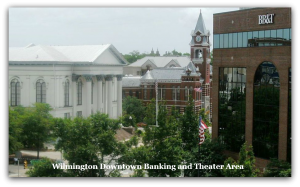 Wilmington is a 250-year-old port city, nestled between North Carolina’s mighty Cape Fear River and the Atlantic Ocean. The city’s riverbanks boast a major container seaport, a charming historical district, a one-mile-long Riverwalk, the Battleship North Carolina, Gothic churches, and riverfront shops. Although Wilmington is the largest city in southeastern North Carolina, it continues to retain a small town atmosphere. Downtown Wilmington is a lively streetscape of restaurants, outdoor cafes, coffee shops, banks, and retail stores— all framed against the backdrop of the Cape Fear River.
Wilmington is a 250-year-old port city, nestled between North Carolina’s mighty Cape Fear River and the Atlantic Ocean. The city’s riverbanks boast a major container seaport, a charming historical district, a one-mile-long Riverwalk, the Battleship North Carolina, Gothic churches, and riverfront shops. Although Wilmington is the largest city in southeastern North Carolina, it continues to retain a small town atmosphere. Downtown Wilmington is a lively streetscape of restaurants, outdoor cafes, coffee shops, banks, and retail stores— all framed against the backdrop of the Cape Fear River.
In 2008, the National Trust for Historic Preservation named Wilmington one of its “Dozen Distinctive Destinations”. Wilmington is a city where the past is honored through the painstaking preservation of its downtown historic district which encompasses nearly 300 blocks. It is among North Carolina’s largest collection of historic buildings and homes. But Wilmington is also a city where old abandoned warehouses on downtown’s northern end have been demolished in recent years, making room for numerous modern projects such as the new Wilmington state-of-the-art convention center and a new marina complex.
 Wilmington’s greatest resource is its location between the Cape Fear River and the Atlantic Ocean. The entire area has an enduring relationship with the water that is interwoven throughout its history. Just as colonists relied on the water for transportation of goods to build the region, so does present day Wilmington rely on it to attract visitors and businesses, and to import and export materials from and to the world through the Port of Wilmington.
Wilmington’s greatest resource is its location between the Cape Fear River and the Atlantic Ocean. The entire area has an enduring relationship with the water that is interwoven throughout its history. Just as colonists relied on the water for transportation of goods to build the region, so does present day Wilmington rely on it to attract visitors and businesses, and to import and export materials from and to the world through the Port of Wilmington.
In 2003 the city was designated by Congress as a “Coast Guard City”, one of only fourteen cities in the country with that designation. It is home port for the USCGC Diligence, a United States Coast Guard medium endurance cutter. Diligence moors up in downtown Wilmington and is the 6th US Coast Guard Cutter to bear that name and be homeported in Wilmington. Diligence is capable of performing any of the missions that white-hulled Coast Guard Cutters traditionally perform; ranging from missions down in the Caribbean, or fisheries protection of the Atlantic seaboard, or search and rescue anywhere in between.
USS North Carolina
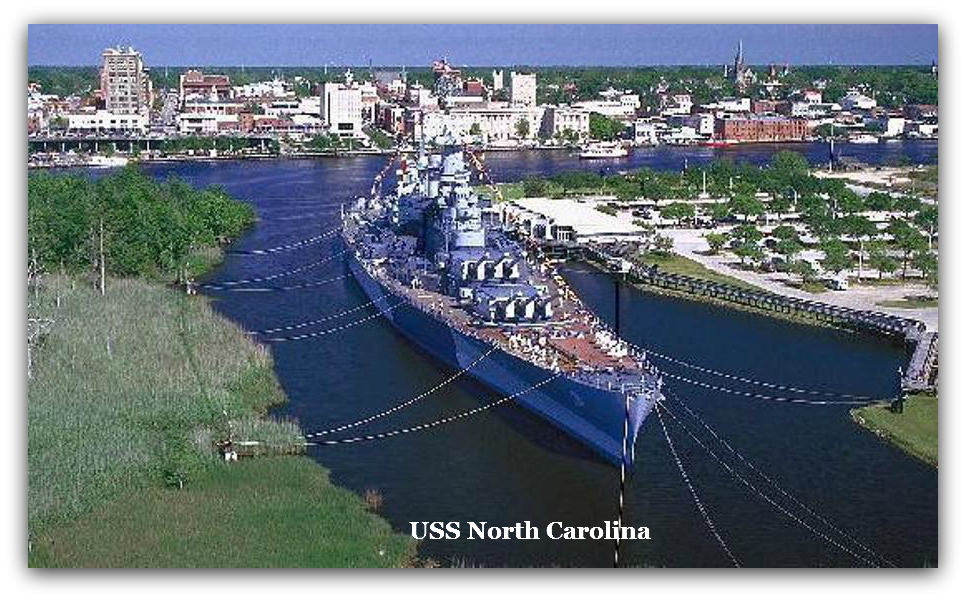 Wilmington is also home to the World War II battleship USS North Carolina, located directly across the Cape Fear River from the historic downtown area. The USS North Carolina was decommissioned in New York on June 27, 1947 and was later removed from the Naval Vessel Register on June 1, 1960 and transferred to the state of North Carolina. The ship was then purchased from the U.S. Navy for $330,000 raised by the efforts of North Carolina school children who saved their spare change and lunch money for the “Save Our Ship” campaign. In 1961, a fleet of tugboats was used to maneuver the 728 foot ship up the Cape Fear River to its present location.
Wilmington is also home to the World War II battleship USS North Carolina, located directly across the Cape Fear River from the historic downtown area. The USS North Carolina was decommissioned in New York on June 27, 1947 and was later removed from the Naval Vessel Register on June 1, 1960 and transferred to the state of North Carolina. The ship was then purchased from the U.S. Navy for $330,000 raised by the efforts of North Carolina school children who saved their spare change and lunch money for the “Save Our Ship” campaign. In 1961, a fleet of tugboats was used to maneuver the 728 foot ship up the Cape Fear River to its present location.
On April 29, 1962, the USS North Carolina was dedicated at Wilmington, North Carolina as a memorial to North Carolinians of all services killed in World War II. The battleship was declared a National Historic Landmark in 1986. Visitors to the USS North Carolina Battleship Memorial can tour the main deck of the ship, many interior compartments, and some of the gun turrets. Various events are held at the memorial including the annual Fourth of July fireworks display from the adjacent battleship park.
Population
Wilmington is the county seat of New Hanover County in coastal southeastern North Carolina. The population within the city is 106,476 according to the 2010 Census. It is the eighth most populous city in the state. Wilmington is the principal city of the Wilmington Metropolitan Statistical Area (“MSA”), a metropolitan area that includes New Hanover, Brunswick, and Pender counties which had a population of 362,315 as of the 2010 Census.
The region has historically been one of the fastest growing population centers in the country. The population growth rate continues to surpass the national and state rates as more and more people of all ages and backgrounds are drawn to the mild climate, beautiful shoreline, historic attractions, and hometown feel of the Cape Fear Coast. Moreover, the region’s high quality of life, low cost of living, abundant education options, world-class healthcare, and inviting business atmosphere adds to the area’s appeal.
New Hanover County which includes the city of Wilmington is among the fastest growing counties in the United States. The county’s population grew from 120,284 to 160,307 or 33.3% between 1990 and 2000 and from 160,307 to 202,667 or 26.4% between 2000 and 2010. New Hanover County’s ten-year population growth rate of 26.4% is much higher than the state average rate of 18.5% and almost three times greater than the national average rate of 9.7%.
Brunswick County is also among the fastest growing counties in the United States and is the second fastest growing county in North Carolina. The county’s population grew from 50,985 to 73,141 or 43.5% between 1990 and 2000 and from 73,141 to 107,431 or 46.9% between 2000 and 2010. Brunswick County’s ten-year population growth rate of 46.9% is more than double the state average rate of 18.5% and is almost five times greater than the national average rate of 9.7%.
The Wilmington MSA, encompassing New Hanover, Brunswick, and Pender counties, had an estimated population of 362,315 in 2010 compared to 274,530 in 2000, an impressive increase of 32%, almost double the state growth rate and more than three times greater than the national growth rate.
Population Growth History for Wilmington Metropolitan Statistical Area
| 2012 | Change | 2011 | Change | 2010 | Change | 2000 | Change | |
|---|---|---|---|---|---|---|---|---|
| New Hanover Co. | 209,234 | 1.6% | 205,951 | 1.6% | 202,667 | 26.4% | 160,307 | 33.3% |
| Brunswick Co. | 112,257 | 1.8% | 110,268 | 2.6% | 107,431 | 46.9% | 73,141 | 43.5% |
| Pender Co. | 54,195 | 1.3% | 53,480 | 2.4% | 52,217 | 27.1% | 41,082 | 42.4% |
| MSA Totals | 375,686 | 1.6% | 369,699 | 2.0% | 362,315 | 32.0% | 274,530 | 37.2% |
| North Carolina | 9,752,073 | 1.0% | 9,656,401 | 1.3% | 9,535,483 | 18.5% | 8,049,331 | 21.4% |
| United States | 313,914,010 | 0.7% | 311,591,917 | 0.9% | 308,745,538 | 9.7% | 281,421,942 | 13.2% |
| Source: U.S. Census Bureau. | ||||||||
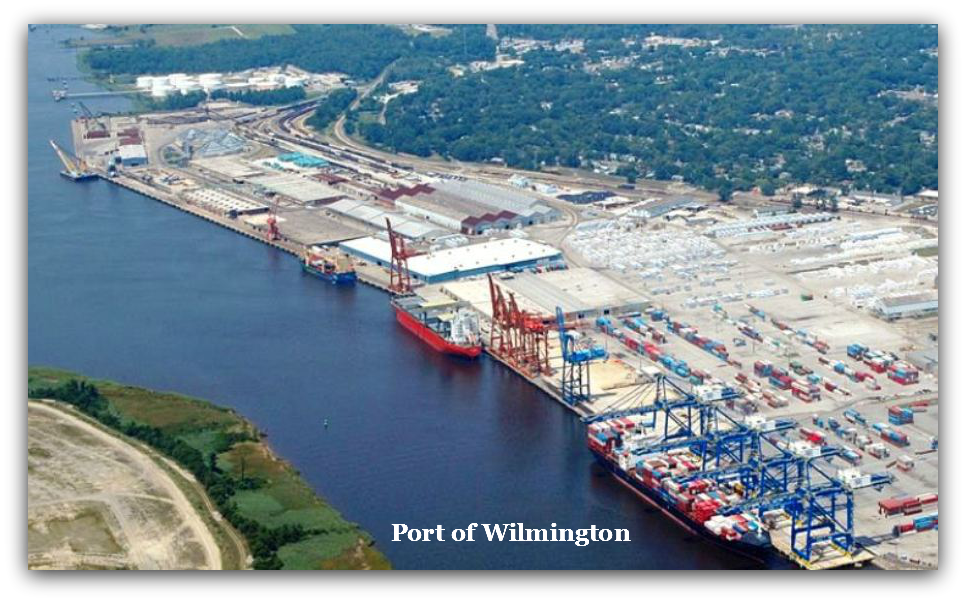
The Port of Wilmington
The North Carolina State Ports Authority was created in 1945 to promote the development of North Carolina industry by establishing two deep-water ports, thus breaking the state’s dependence on ports in Virginia and South Carolina. The terminals, one in Morehead City and one in Wilmington, were equipped to handle ocean-going vessels and opened in 1952. Today they are the backbone of the North Carolina shipping industry and have made a major contribution to the state’s economy. The Port of Wilmington is strategically located on the U.S. East Coast and is the closest Port to major points on the I-85 Corridor, including Charlotte, Greensboro, and Raleigh-Durham. The Ports’ central Eastern seaboard location is closest to the center of the southeast US market — the fastest growing region in the country.
Recent improvement to regional and national highway networks make surface transportation supporting the Port of Wilmington’s container terminal superior to neighboring ports. In addition, the CSX Intermodal National Gateway Project connects Wilmington to the rail intermodal transportation network and important growth markets and current distribution centers.
Recent improvement to regional and national highway networks make surface transportation supporting the Port of Wilmington’s container terminal superior to neighboring ports. In addition, the CSX Intermodal National Gateway Project connects Wilmington to the rail intermodal transportation network and important growth markets and current distribution centers.
A channel-deepening project in the Cape Fear River completed in 2008 increased channel depth to 42 feet from the river’s mouth to the port to accommodate larger ships. Since that time, the port’s capacity has tripled as a result of improvements to the dock infrastructure and terminal operating system in the first phase of Wilmington’s container terminal expansion. Modern transit and warehousing facilities, state-of-the-art Post-Panamax container cranes and support equipment, and the latest in cargo management technology provide a broad platform for supporting international trade to the fast growing Southeast market.
The Port of Wilmington has experienced rapid growth in recent years. In fiscal year 2012 the Port of Wilmington received more than 460 ships loaded with diverse cargoes from Europe, South America, and the Far East. Cargo tonnage through the port was approximately 4.4 million tons in 2012 compared to 3.5 million tons in 2011 and 2.2 million tons in 2003. The number of container TEUs (Twenty-foot Equivalent Units) exceeded 276,000 in 2012 compared to 99,000 in 2003.
Port of Wilmington 10 year Tonnage Trend
| Year | Breakbulk | Container | Bulk | Totals | TEU’s |
|---|---|---|---|---|---|
| 2012 | 271,878 | 2,153,552 | 1,958,672 | 4,384,102 | 276,567 |
| 2011 | 317,877 | 2,154,539 | 1,052,057 | 3,524,473 | 290,666 |
| 2010 | 207,335 | 1,917,237 | 1,304,755 | 3,429,237 | 250,048 |
| 2009 | 413,446 | 1,338,436 | 1,322,963 | 3,074,844 | 194,608 |
| 2008 | 701,993 | 1,404,401 | 1,361,815 | 3,468,209 | 204,896 |
| 2007 | 897,776 | 1,174,335 | 1,368,550 | 3,440,661 | 173,111 |
| 2006 | 1,235,331 | 955,370 | 1,270,589 | 3,461,290 | 166,625 |
| 2005 | 1,271,417 | 781,046 | 951,601 | 3,004,064 | 133,723 |
| 2004 | 1,054,214 | 624,170 | 648,381 | 2,326,765 | 96,077 |
| 2003 | 976,082 | 613,923 | 630,799 | 2,220,804 | 99,677 |
| Source: Port of Wilmington 2012 Statistics | |||||
Warehousing at the port includes almost one million square feet of prime covered and sprinklered storage with 100-plus acres of paved storage area and 25 acres of semi-improved open storage area. The port has rail access to berths,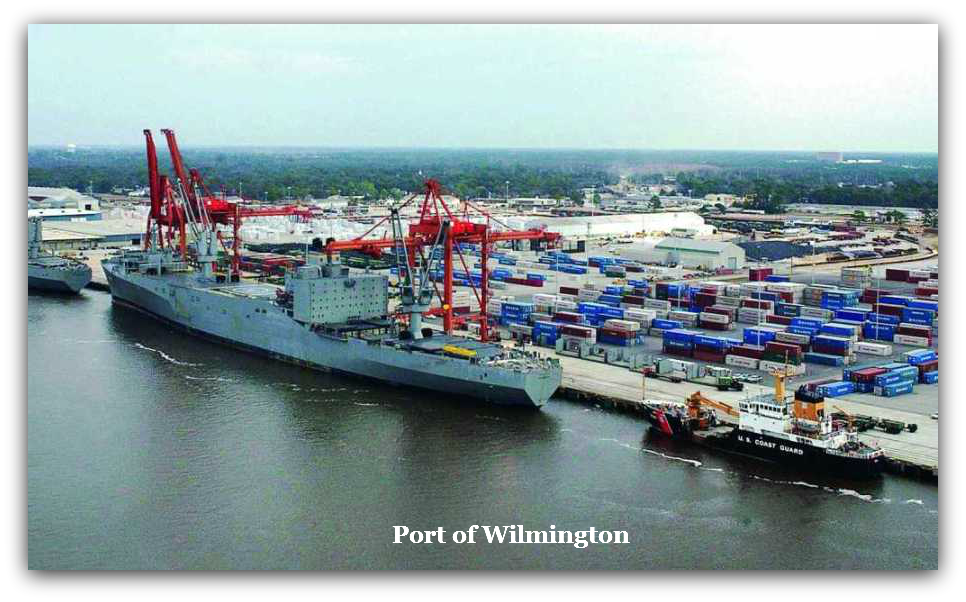 transit sheds, warehouses and open storage and direct transfer of heavy lift and dimensional loads between vessel and rail or truck. The entire Wilmington Terminal is approved as Foreign Trade Zone 66. Countries that do significant business through the Port of Wilmington include China, Great Britain, Belgium, South Korea, Turkey, Taiwan, and Canada. Top imports for fiscal year 2012 were chemicals, grains, urea, ore, mica, and machinery parts. Primary exports were forest products, wood pulp, wood chips, general merchandise, and food products.
transit sheds, warehouses and open storage and direct transfer of heavy lift and dimensional loads between vessel and rail or truck. The entire Wilmington Terminal is approved as Foreign Trade Zone 66. Countries that do significant business through the Port of Wilmington include China, Great Britain, Belgium, South Korea, Turkey, Taiwan, and Canada. Top imports for fiscal year 2012 were chemicals, grains, urea, ore, mica, and machinery parts. Primary exports were forest products, wood pulp, wood chips, general merchandise, and food products.
In an effort to expand ever further, The Ports Authority is currently working closely with the N.C. Department of Commerce on an aggressive program to site additional major distribution centers in the immediate vicinity of the Port. Excellent sites are available for distribution center placement, as well as a labor pool well suited to fill materials handling positions. In addition, the North Carolina community college system has developed a course of study specifically for retail distribution center training. Current and planned improvements in the regional transportation network provide a new platform for distribution when combined with upgraded capabilities at the Port of Wilmington to handle large quantities of imported goods.
Top Ten Trading Partners Fiscal Year 2012
| Import | Tons | Export | Tons | Total Trade | Tons |
|---|---|---|---|---|---|
| China | 349,445 | China | 599,891 | China | 949,336 |
| Great Britain | 348,361 | Turkey | 320,063 | Great Britain | 463,390 |
| Tobago-Trinadad | 203,693 | So. Korea | 199,414 | Belgium | 353,874 |
| Canada | 164,772 | Belgium | 192,357 | So. Korea | 341,252 |
| Belgium | 161,517 | Great Britain | 115,029 | Turkey | 320,063 |
| So. Korea | 141,838 | Taiwan | 94,605 | Tobago-Trinadad | 203,693 |
| Russia | 126,082 | Italy | 88,139 | Taiwan | 169,399 |
| Colombia | 96,159 | Honduras | 84,471 | Canada | 164,772 |
| Taiwan | 74,794 | Netherlands | 64,042 | Russia | 126,927 |
| Chile | 36,137 | Guatemala | 19,464 | Honduras | 119,187 |
| Source: Port of Wilmington 2012 Statistics | |||||
Wilmington Economy
The Wilmington area’s economy is driven by a major seaport (Port of Wilmington), a major university (UNC-Wilmington), world-class healthcare (New Hanover Regional Medical), a thriving film industry (EUE/Screen Gems Studios), and a major tourism industry. In addition, Wilmington has an industrial base that includes electrical, electronic and telecommunications equipment, pharmaceuticals, nuclear fuel, clothing and apparel, food processing, and paper products— all of which creates a stable economic base. The synergy between the area’s high-tech companies and UNC-Wilmington/Cape Fear College is helping to establish Wilmington as a hub for research and development.
Wilmington’s inviting business climate has attracted giants like G.E., DuPont, and Corning, as well as major high-tech firms such as AAIPharma and Pharmaceutical Product Development (PPD). Furthermore, the State of North Carolina ranks as one of the most business-friendly in the country. The combination of these factors makes the area highly desirable for corporate expansion and for people looking for a better quality of life.
First Quarter 2013 Cost of Living – Select Southern Cities
| City | Composite | Grocery | Housing | Utilities | Transportation | Healthcare | Misc |
|---|---|---|---|---|---|---|---|
| Wilmington, NC | 98.8 | 106.9 | 80.1 | 102.8 | 100.6 | 97.8 | 109.2 |
| Raleigh, NC | 92.2 | 103.5 | 69.3 | 105.3 | 97.6 | 101.5 | 99.2 |
| Charlotte, NC | 94.7 | 98.2 | 82.9 | 102 | 98.8 | 100.6 | 98.5 |
| Asheville, NC | 103.6 | 106.3 | 78.2 | 85.2 | 99.2 | 101.8 | 105.3 |
| Charleston, SC | 99.5 | 107.4 | 84.6 | 114.1 | 99 | 105.2 | 97.1 |
| Washington, D.C. | 141.7 | 111.3 | 246.6 | 111.6 | 104.1 | 103.3 | 96.2 |
| Norfolk, VA | 99.2 | 93.7 | 96.2 | 112.3 | 96.2 | 98.5 | 101.2 |
| Source: ACCRA Cost of Living Index 2013 | |||||||
The ACCRA Cost of Living Index measures the differences in the cost of consumer goods and services between cities, excluding taxes, for a middle-class standard of living. Approximately 300 urban areas in the United States participated in the most recent study. The results are based on the cost of more than 60 items that are priced by area chambers of commerce, economic development groups or similar organizations in each urban area during the same 3-day time frame. Each community is given a composite index in which the average score is 100 (if index numbers are above 100, they are more expensive than the average), derived from six categories. The index does not measure inflation. Instead, it serves as a snapshot of comparative costs between cities during a certain time period. Wilmington’s latest study scores, compared to other southern cities, are shown in the table above.
Employment
Job growth is an important economic indicator of the health of a regional economy and is also a factor in the demand for all types of housing. The Wilmington MSA experienced robust job growth from 2001 through 2006, adding a total of 33,192 new jobs during that period— from total MSA employment of 134,352 jobs in 2001 to 167,544 in 2006. During that same period, the total MSA labor force increased by 29,931 from 144,467 in 2001 to 174,398 in 2006. The MSA unemployment rate was 3.9% at the end of 2006.
In the recession years 2007 through 2009, the MSA lost 9,287 jobs but the total labor force declined by only 3,015, thus resulting in an unemployment rate of 10.8% by the end of 2009. By the end of 2012, all but 1,771 of the jobs lost during the recession had been recovered; however, the unemployment rate for the MSA remained above 10% due to the fact that the total labor force actually increased by 9,769 during that same period. In other words, unlike the national trend where the unemployment rate declined during that period due primarily to a declining participation rate (shrinking labor force), the unemployment rate for the Wilmington MSA remained high through 2012 for the opposite reason, a growing labor force. According to the North Carolina Employment Commission (now called “Division of Employment Security”), the Wilmington MSA which includes New Hanover, Brunswick, and Pender counties, added 6,280 new jobs during 2012, an increase of 3.4%, but the MSA labor force increased by 6,050— thus, no meaningful reduction in the unemployment rate during 2012. However, as indicated in the table below, 2,507 new jobs were added during 2013 while the labor force actually decreased by 3,192, thus resulting in a 7% unemployment rate by the end of 2013.
Employment History For Wilmington Metropolitan Statistical Area
| 2003 | 2004 | 2005 | 2006 | 2007 | 2008 | 2009 | 2010 | 2011 | 2012 | 2013 | |
|---|---|---|---|---|---|---|---|---|---|---|---|
| Labor Force | 151,169 | 156,982 | 165,592 | 174,398 | 173,333 | 177,779 | 177,413 | 178,824 | 178,117 | 184,167 | 180,975 |
| Increase | 3,220 | 5,813 | 8,610 | 8,806 | (1,065) | 4,446 | (366) | 1,411 | (707) | 6,050 | (3,192) |
| % Change | 2.2% | 3.8% | 5.5% | 5.3% | -0.6% | 2.6% | -0.2% | 0.8% | -0.4% | 3.4% | -1.7% |
| Employed | 143,331 | 149,724 | 159,079 | 167,544 | 165,278 | 163,649 | 158,257 | 159,770 | 159,493 | 165,773 | 168,280 |
| Increase | 5,162 | 6,393 | 9,355 | 8,465 | (2,266) | (1,629) | (5,392) | 1,513 | (277) | 6,280 | 2,507 |
| % Change | 3.7% | 4.5% | 6.2% | 5.3% | -1.4% | -1.0% | -3.3% | 1.0% | -0.2% | 3.9% | 1.5% |
| Unemployed | 7,838 | 7,258 | 6,513 | 6,854 | 8,055 | 14,130 | 19,156 | 19,054 | 18,624 | 18,394 | 12,695 |
| Rate | 5.2% | 4.6% | 3.9% | 3.9% | 4.6% | 7.9% | 10.8% | 10.7% | 10.5% | 10.0% | 7.0% |
| Source: Employment Security Commission of North Carolina | |||||||||||
The largest industrial companies in the area include Corning Glass Works (the Wilmington location is the largest manufacturer of optical fibers in the world); General Electric (aircraft engine parts, nuclear fuel components); Progress Energy; International Paper; KoSa (chemicals); PPD (pharmaceutical research); Louisiana Pacific (wood products); Terex American Crane; VisionAir (software); Verizon; Oracle Packaging; Del Laboratories; L.L. Building Products; AAIPharma (pharmaceutical products); and Interroll (conveyor components).
Also important to Wilmington’s economy is tourism due to its close proximity to the ocean and the Cape Fear River. Film production has become an important element in the city’s economy as well. Wilmington has grown into the third most active film location, behind only Los Angeles and New York. EUE/Screen Gems Studios in Wilmington is the largest production facility in the United States outside of California.
New Hanover Regional Medical Center
The largest employer with more than 4,700 employees in the region, New Hanover Regional Medical Center is a not-for-profit health care system serving southeastern North Carolina and northeastern South Carolina. A teaching hospital, regional referral center, and Level 2 Trauma Center, New Hanover Regional Medical Center is joined in the network by Cape Fear Hospital, Pender Memorial Hospital, Zimmer Cancer Center and the Betty H. Cameron Women’s and Children’s Hospital. The system also includes outpatient imaging and diagnostic centers, NHRMC Physician Group, NHRMC Urgent Care and NHRMC Home Care. Dedicated to patient care and community outreach, the Network provides more than $120 million in uncompensated care to the community each year.
PPD
 PPD is a leading global contract research organization providing drug discovery, development and lifecycle management services. Their clients and partners include pharmaceutical, biotechnology, medical device, academic and government organizations. Founded in Wilmington, the company has offices in 46 countries with more than 12,000 professionals worldwide. Their international headquarters is in downtown Wilmington. PPD applies innovative technologies, therapeutic expertise and a commitment to quality to help clients and partners accelerate the delivery of safe and effective therapeutics and maximize the returns on their R&D investments.
PPD is a leading global contract research organization providing drug discovery, development and lifecycle management services. Their clients and partners include pharmaceutical, biotechnology, medical device, academic and government organizations. Founded in Wilmington, the company has offices in 46 countries with more than 12,000 professionals worldwide. Their international headquarters is in downtown Wilmington. PPD applies innovative technologies, therapeutic expertise and a commitment to quality to help clients and partners accelerate the delivery of safe and effective therapeutics and maximize the returns on their R&D investments.
General Electric
Wilmington is fortunate to have a Fortune 500 company such as General Electric as one of its major employers. Housing components of both the nuclear energy business and aircraft engine business, the Castle Hayne facility employs more than 2000 people. In addition to providing stable, high-payng employment and benefits, the company has been a generous charitible partner in the community since locating here in 1968.
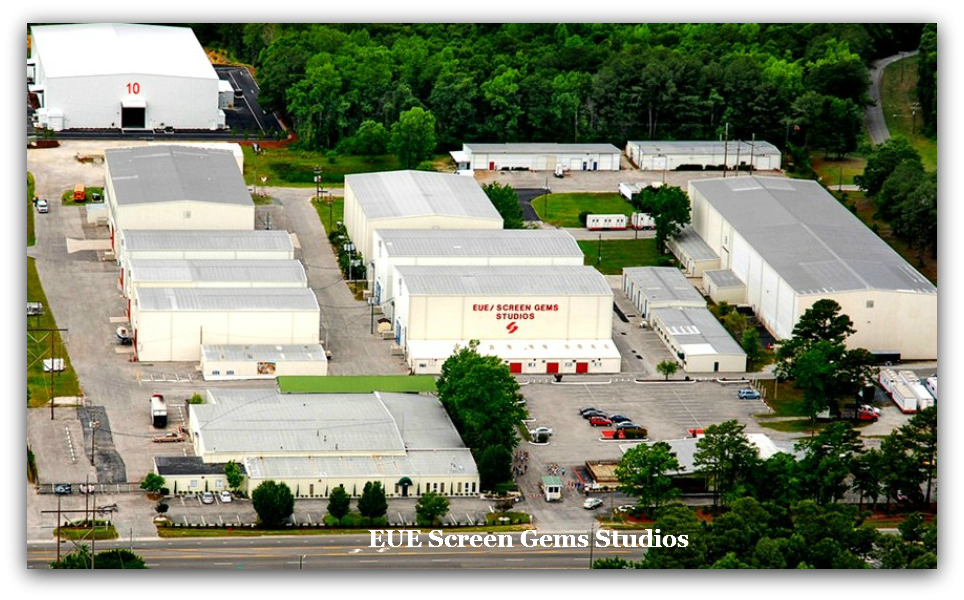 The Film Industry
The Film IndustryThe unique characteristics of the Wilmington area helped draw the film industry to the city in 1983. Since that time, Wilmington has grown into the third most active film location, behind only Los Angeles and New York. Wilmington is the home of EUE Screen Gems Studios, the largest domestic television and movie production facility outside of California. In 2009, “Dream Stage 10”, currently one of the largest sound stages in the world, was added to the Wilmington facility. It houses the largest special-effects water tank in North America.
EUE/Screen Gems Studios in Wilmington has been home to over 350 film, television, and commercial productions including TV series like Matlock, Dawson’s Creek, One Tree Hill, Surface, Revolution, and more recently Steven King’s “Under the Dome”. Major motion pictures include Blue Velvet, Domestic Disturbance, Firestarter, Crimes of the Heart, Nights in Rodanthe, and Safe Haven, to name just a few. In 2012, Marvel Studios chose to use EUE/Screen Gems Studios in Wilmington for the filming of “Iron Man 3” starring Robert Downey Jr., Gwyneth Paltrow, and Scarlett Johansson. This major motion picture, released in 2013, was the largest film production to shoot in North Carolina.



The Wilmington Regional Film Commission, located on the EUE/Screen Gems Studios lot, facilitates on-location filmmaking in the Cape Fear region. Filmmakers have access to a broad base of local talent and professional film crews along with the facilities at Screen Gems Studios. EUE/Screen Gems Studios offers many amenities to film and television production companies. The studio’s lot features 10 stages, post-production services, more than 20,000 square feet of production office space, a 40-seat screening room, editing suites, sound transfer services, lighting and grip equipment rental, set construction shops and much more. In addition to the studios, production companies discover a wealth of experienced film crew professionals, estimated at 650 in the greater Wilmington region.
Tourism
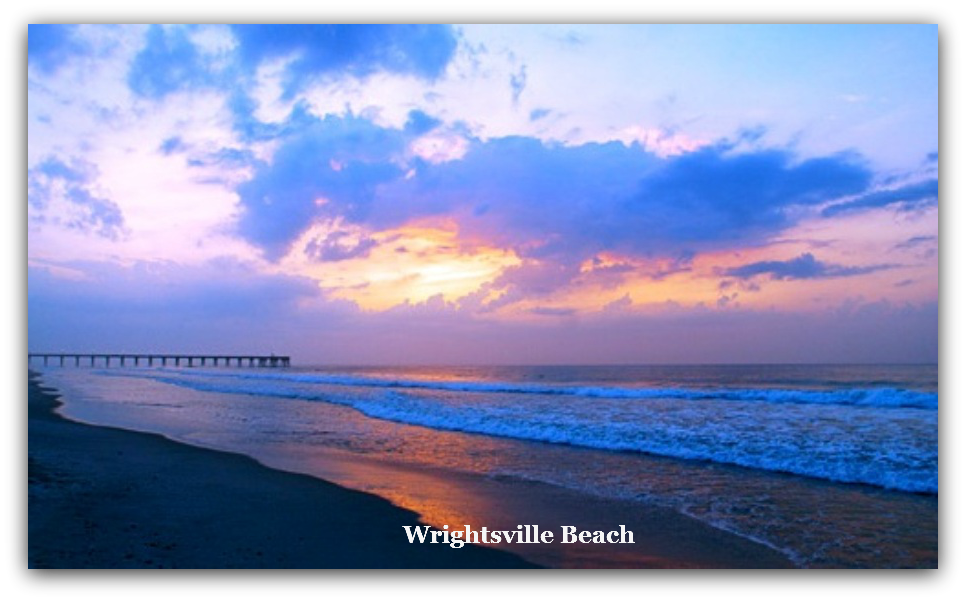 Tourism remains one of the most important industries in North Carolina and this is especially true in the southern coastal region. With an appealing variety of attractions— beaches and waterways, breathtaking gardens, a rich arts environment, well-established cultural events, beautiful historic homes and landmarks, and moderate year-round temperatures, the Wilmington area is a highly desirable destination for visitors from all over the country.
Tourism remains one of the most important industries in North Carolina and this is especially true in the southern coastal region. With an appealing variety of attractions— beaches and waterways, breathtaking gardens, a rich arts environment, well-established cultural events, beautiful historic homes and landmarks, and moderate year-round temperatures, the Wilmington area is a highly desirable destination for visitors from all over the country.
Visitors traveling to and within the state of North Carolina spent a record $19.4 billion in 2012, supporting more than 40,000 North Carolina businesses and directly supporting nearly 200,000 jobs all across the state. State and local tax revenues generated as a result of visitor spending totals more than $1.5 billion annually. North Carolina ranks as the 6th most visited state in the United States. The state’s natural scenic beauty, rich history and culture, vibrant cities, quaint small towns, and central east coast location make it an ideal travel destination. And, the abundance of direct air access into the state from national and international destinations around the globe have helped to position it as preferred international travel destination.
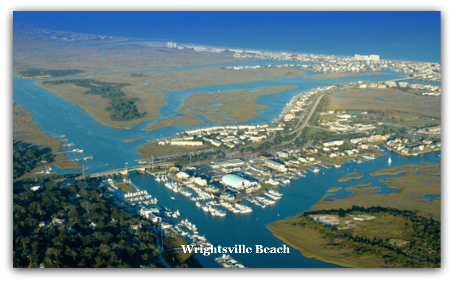 With more than 50 championship golf courses and a long mid-March through mid-November playing season, golf is another major draw to the region. Restaurants number in the hundreds and continue to proliferate at an astounding rate, with the best of them enjoying capacity dining on weekends. Special attractions and activities such as horse-and-carriage rides in the historic district, boat tours, sailing charters, a downtown Wilmington walking tour, the free trolley, Riverwalk and educational tours in the historic district continue to respond to high demand.
With more than 50 championship golf courses and a long mid-March through mid-November playing season, golf is another major draw to the region. Restaurants number in the hundreds and continue to proliferate at an astounding rate, with the best of them enjoying capacity dining on weekends. Special attractions and activities such as horse-and-carriage rides in the historic district, boat tours, sailing charters, a downtown Wilmington walking tour, the free trolley, Riverwalk and educational tours in the historic district continue to respond to high demand.
According to the Visitors Bureau, summer is no longer the sole tourism season. Wilmington and the surrounding communities have moved from a three-month to a nearly year-round tourism season, with the majority of visitors arriving from March through November. Accommodations are plentiful in the Greater Wilmington area and coastal Brunswick County. Historic downtown Wilmington and picturesque Southport offer a bounty of charming bed and breakfast inns. Still, it is often difficult to find lodgings on short notice during the summer, and advance reservations for these months are highly recommended.
University of North Carolina at Wilmington
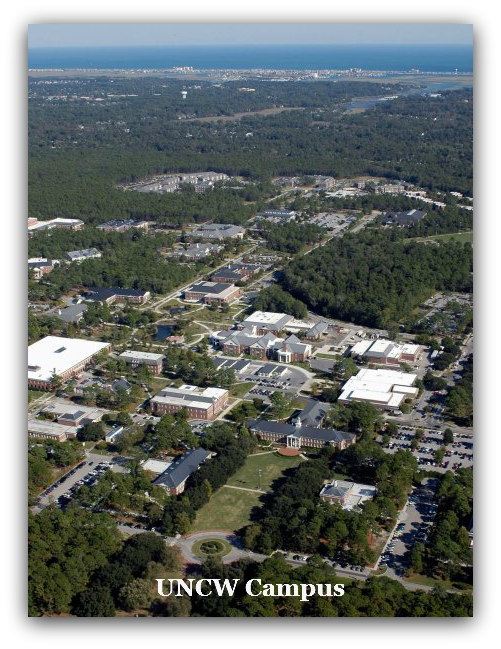 The University of North Carolina at Wilmington (UNCW), sometimes referred to as UNC Wilmington, is a public, co-educational university located in Wilmington, North Carolina. UNCW enrolls approximately 13,000 undergraduate, graduate and doctoral students each year as part of the 17-campus University of North Carolina System.
The University of North Carolina at Wilmington (UNCW), sometimes referred to as UNC Wilmington, is a public, co-educational university located in Wilmington, North Carolina. UNCW enrolls approximately 13,000 undergraduate, graduate and doctoral students each year as part of the 17-campus University of North Carolina System.
UNC Wilmington opened its doors on September 4, 1947 as Wilmington College. At the time the school operated as a junior college, offering freshman-level courses to nearly 250 students during the first school year, many of whom were veterans returning from military service following World War II. Under the control of the New Hanover County Board of Education, Wilmington College earned accreditation from the North Carolina College Conference in 1948 and became a member of the American Association of Junior Colleges. Further accreditation came in 1952 from the Southern Association of Colleges and Schools.In 1958, Wilmington College was placed under the Community College Act of North Carolina, passing control from the New Hanover County Board of Education to a board of trustees as a state-supported college under the supervision of the North Carolina Board of Higher Education.
Wilmington College became a senior college on July 1, 1963, when the North Carolina General Assembly passed legislation allowing the school to offer a four-year curriculum and award bachelor’s degrees. Six years later, July 1, 1969, the name of the school was changed to The University of North Carolina at Wilmington, making UNCW the fifth campus of the University of North Carolina system.
On August 22, 1977, UNCW was authorized to offer its first graduate programs at the master’s level. Currently, UNCW has around 13,000 students enrolled and nearly 500 full-time faculty members. The school offers fifty-two bachelor’s degrees, thirty-six master’s degrees and doctoral degrees in marine biology and educational leadership and administration.
| 2003 | 2004 | 2005 | 2006 | 2007 | 2008 | 2009 | 2010 | 2011 | 2012 | 2013 | |
|---|---|---|---|---|---|---|---|---|---|---|---|
| Undergraduate | 9,974 | 10,514 | 10,723 | 10,955 | 11,026 | 11,311 | 11,591 | 11,743 | 11,903 | 12,348 | 12,428 |
| Graduate | 955 | 1,060 | 1,116 | 1,143 | 1,154 | 1,332 | 1,333 | 1,328 | 1,242 | 1,385 | 1,509 |
| TOTAL | 10,929 | 11,574 | 11,839 | 12,098 | 12,180 | 12,643 | 12,924 | 13,071 | 13,145 | 13,733 | 13,937 |
| One Year Change | 1.86% | 5.90% | 2.29% | 2.19% | 0.68% | 3.80% | 2.22% | 1.14% | 0.57% | 4.47% | 1.49% |
| Cumulative Change | 3.11% | 9.20% | 11.70% | 14.14% | 14.92% | 19.28% | 21.94% | 23.32% | 24.02% | 29.57% | 31.49% |
| Source: University of North Carolina at Wilmington | |||||||||||
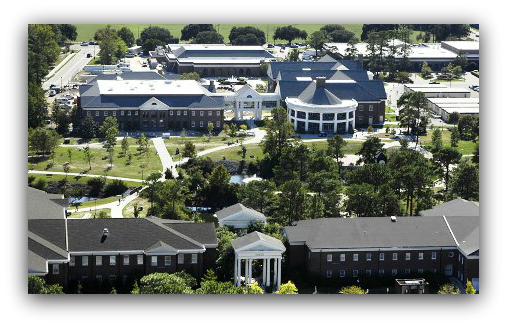 The university offers degrees in humanities, sciences, health, business and professional fields. The university’s highly ranked marine science program draws a variety of undergraduate and graduate students from across the United States. The proximity to the Atlantic Ocean is a draw for incoming freshman.
The university offers degrees in humanities, sciences, health, business and professional fields. The university’s highly ranked marine science program draws a variety of undergraduate and graduate students from across the United States. The proximity to the Atlantic Ocean is a draw for incoming freshman.
Teal is the official school color of UNCW, with navy and gold as alternate colors.
The school color has become a point of pride for students, which is widely illustrated with spirit shirts bearing slogans such as “Feel My Teal” and exclusive teal-colored Rainbow Sandals being offered through the university bookstore. The average SAT score for incoming freshman in 2010 was 1170, with an average GPA of 3.79. The freshman class in 2010 was 1,992.
Student Facilities
In 2000, the Student Recreation Center was opened to students, staff, and faculty members. It houses three basketball courts, exercise machines, a weight training area, an indoor running track, and an indoor climbing wall. It also includes a group exercise room which supports multiple clubs and activities, including Yoga, Pilates, and an Aikido club. By 2012, the Student Recreation Center will complete an expansion of facilities, as well as construction on a new natatorium. This construction will double the size of the existing Recreation Center.
Lumina Theater, named after the boardwalk theater that was once found on Wrightsville Beach features 360 stadium seats, a 15.5′ x 30′ screen, Dolby Digital surround sound, 35mm capabilities and a digital projection system. Lumina screens blockbusters, independents, cult classics, art films, international films and student films throughout the academic year, four or more days a week, except during University holidays and breaks. Some notable Lumina events included a multi-part, high-definition screening of BBC’s Planet Earth series over the span of several weekends, and a yearly 24-hour lock-in.
Residential Accommodation
Galloway Hall is UNCW’s first residence facility on campus, and has a standard hall-style double room arrangement with shared bathrooms for the entire hall. Housing 400 students, predominately first-years, Galloway has a very social atmosphere.
Graham-Hewlett and Belk dormitories are configured in suite-style dorm arrangements with eight to ten individuals sharing a bathroom. Graham-Hewlett houses 384 residents and Belk houses 192 residents, and both facilities consist of predominately first-year students. Belk is the only dorm on campus which is exclusively female, as all other dorms are coed.
Schwartz Hall houses 160 residents, and is home to mostly first-year students. A double room layout features shared bathrooms but is distinguished by its “pod” layout in contrast with the typical hall style dorms. Schwartz Hall is also home to special interest housing, which includes the “Men of Teal” floor, “Teaching Fellow” floor and “Wellness” floor.
Newer dormitories on campus include Honors (100 Honors Scholar residents), International (100 international and American residents) and Cornerstone Hall (265 residents arranged in “Learning Communities”) and are arranged with a courtyard between them to form what is referred to as “Tri-house”. These dormitories were constructed in the late 1990s and early 2000s and are considered to be the most luxurious and well-maintained freshmen residences on campus.
In addition to dormitories, UNCW also has on campus apartments and suites. There are 13 apartment buildings which can serve as home to 400 students. The University Apartments house 4 students, who all have separate bedrooms but share a bathroom, living room, and kitchen.
The University Suites, built in the late 1980s include seven suite buildings which can also house 400 students. Two floor plans consist of six bedroom units housing 12 students and 10 bedroom units housing ten students. All residents of the Suites share bathrooms, living rooms, and kitchens. University Suites are home to various sororities and fraternities on campus.
Seahawk Village is a luxury apartment complex of six buildings housing 85 students each. With a similar design to off-campus accommodations, Seahawk Village houses predominately upperclassmen. Seahawk Village features a club house with swimming pool, and includes a mix of two, three, and four bedroom apartments with a total of 524 beds. The apartments are fully furnished and feature a full service kitchen and washer and dryer in each apartment.
Seahawk Landing features living arrangements similar to that found in the Seahawk Village facility, with expanded amenities including a sandwich/coffee shop, convenience market, and small-scale recreation facility located on site. Seahawk Landing houses 603 students in seven apartment buildings, predominately upperclassmen.
Seahawk Crossing, opened in 2009, is the most recent addition to residential facilities on campus. Seahawk Crossing’s four apartment buildings comprise four, six, and eight bedroom apartments and house 662 students. Apartment-pod style rooms are fully furnished, and residents are allowed access to the Seahawk Crossing parking deck.
Off-Campus Housing
There are many apartments and condos in the neighborhoods surrounding the university. The Seahawk Perch, which is maintained by the Dean of Students Office, is available to assist off-campus students.
Campus Dining
UNCW has several options for campus dining. The primary venue for dining on campus is Wagoner Hall. Wagoner Hall serves as a standard dining hall setup, with various stations offering a variety of foods, including a salad bar and assorted desserts. Wagoner Hall is also host to “Wagsgiving”, an annual Thanksgiving feast arranged for students.
The newly renovated Dub’s Café, located in Warwick Hall, offers fewer options than Wagoner Hall, but is modeled in a similar cafeteria style. The Fisher University Union houses Hawk’s Nest, a dining center where students can choose from a wide assortment of available options. Hawk’s Nest offers Mexican food, pizza, Asian cuisine, hamburgers and fries, sushi, Chick-fil-A and Quiznos.
Other on-campus dining options include Einstein’s Bagels, Courtside Bagel Shop, Dunkin Donuts, Java City, Landing Sandwich Shop and multiple convenience stores.
Greek Life
Greek-letter societies became an early part of student life at UNCW when the first social fraternity was formed in January 1964, just six months after Wilmington College became a four-year institution. Fraternities and Sororities have continued to grow at UNCW with membership now above 10 percent of the overall student population, exceeding the national average. The Interfraternity Council (IFC) comprises 12 fraternities, and the Panhellenic Council is made up of 9 sororities. The National Pan-Hellenic Council has 7 historically-black organizations, three fraternities and four sororities. UNCW also has two additional special interest sororities. Several fraternities and sororities have on-campus housing in Schwartz Hall, University Suites and University Apartments.
Academics
The university is organized into five colleges:
- College of Arts and Sciences
- Cameron School of Business
- College of Health and Human Services
- Watson School of Education
- Graduate School
The university has 52 undergraduate degree programs, 36 masters degree programs and two doctoral programs.
Randall Library
William Madison Randall Library supports the mission of the UNCW through the provision of information resources, services and programs relevant to the needs of its students, faculty and staff. To accomplish this mission, the library provides diverse collections of informational resources in multiple formats, access to informational resources and assistance and instruction in identifying, evaluating and interpreting information.
Randall Library has two floors. The first floor features computer banks, group work areas, the Technology Assistance Center, and a coffee shop for students. The floor has a very social atmosphere, and is commonly used to complete group assignments. The second floor has a strictly enforced quiet policy.
National Undersea Research Center
National Oceanic and Atmospheric Administration (NOAA) founded the National Undersea Research Program’s National Undersea Research Center (NURC) for the Southeastern United States and Gulf of Mexico at UNCW in 1980. NOAA’s Aquarius laboratory is an underwater habitat located in the Florida Keys National Marine Sanctuary, adjacent to Conch Reef and is operated by UNCW/ NURC.
Center for Marine Science
UNCW’s Center for Marine Science (CMS), ranked fifth in the world, is at the forefront of applied research in the fields of oceanography, coastal and wetland studies, marine biomedical and environmental physiology, and marine biotechnology and aquaculture. Over $50 million in facilities have been built using Endowment, University, State, and Federal sources. In 2000, a new $17.5 million facility located in the Myrtle Grove area of Wilmington was completed. This facility is directly accessible from the Intracoastal Waterway, has docking facilities, and currently offers more than 110,000 square feet of net indoor space with the recent completion of the 11,000 square foot Oyster Hatchery. Another addition, the 69,000 square foot Marine Biotechnology Building, is slated for completion in 2013. Research funding has grown from approximately $9 million in 2001 to more than $38 million in 2010.
Athletics
The UNCW athletic teams are known as the Seahawks. They are NCAA’s Division I members and field 19 varsity athletic teams for men and women. UNCW has the highest student-athlete graduation rate for public universities in the state of North Carolina.
UNCW is a member of the Colonial Athletic Association. Other members of the conference include University of Delaware, Drexel, George Mason, Georgia State, Hofstra, James Madison, Northeastern, Old Dominion, Towson, VCU and William & Mary.
Baseball
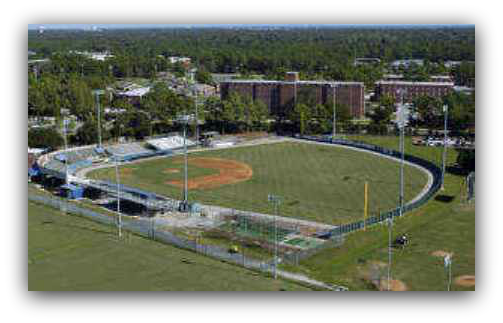 UNCW won the CAA’s automatic bid to play in the NCAA Regionals in 2004 and 2006. In addition, the program received at-large bids to the NCAA Tournament in 2003 and 2008. UNCW set a CAA record with four consecutive 40-win seasons from 2003–06 and set a school record with 44 victories in 2008, including a 21-game winning streak. The rich heritage of UNCW baseball began when the Seahawks captured the NCJAA 1961 and 1963 National Championships. The Seahawks have sent over 82 players to play professionally. UNCW has hosted the CAA baseball tournament at Brooks Field eight consecutive years and 10 times overall.
UNCW won the CAA’s automatic bid to play in the NCAA Regionals in 2004 and 2006. In addition, the program received at-large bids to the NCAA Tournament in 2003 and 2008. UNCW set a CAA record with four consecutive 40-win seasons from 2003–06 and set a school record with 44 victories in 2008, including a 21-game winning streak. The rich heritage of UNCW baseball began when the Seahawks captured the NCJAA 1961 and 1963 National Championships. The Seahawks have sent over 82 players to play professionally. UNCW has hosted the CAA baseball tournament at Brooks Field eight consecutive years and 10 times overall.
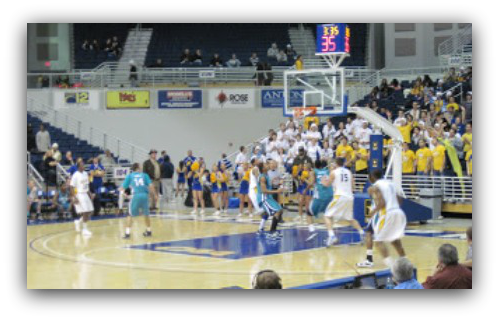
Men’s Basketball
UNCW basketball has been popular on campus since the program moved to Division I in 1976-77. The Seahawks finished their inaugural season with a 16-10 record, a rare accomplishment for any program in their first year of D-I competition. Success continued in the second season when a sellout crowd attended the opening game in Trask Coliseum and witnessed a near upset of nationally-ranked Wake Forest 83-79. The Seahawks finished the 1977-78 season with a 19-7 record.
In 1984, the Seahawks joined the ECAC-South Conference (also known as the Colonial Athletic Association). In their first conference home game at Trask Coliseum the Seahawks defeated George Mason. The first appearance in a CAA championship game came in 1987, just their third season of league play that saw them finish the regular season in 2nd place. UNCW would appear in three more CAA title games (1989, 1996, 1998) before capturing their first championship in 2000 with a 57-47 win over Richmond. UNCW won the title again in 2006 by beating Hofstra, 78-67.
The Seahawks’ first votes in any Top 25 poll came early in the 1992-93 season. Other notable wins that captured the attention of pollsters included roads wins at Miami (FL) and NC State (96-84). The first appearance in post-season play came in 1998 when they were selected for the NIT. They played again in the NIT in 2001.
UNCW has made four appearances in the NCAA Tournament. Their first trip came in 2000, where they lost to the #2 seed Cincinnati, 64-47. In their second appearance in 2002, the 13th seeded Seahawks shocked the 4th seeded Trojans of USC with a 93-89 overtime win. They were defeated by Indiana in the second round, 76-66. In 2003 the Seahawks faced off against Maryland. Maryland won the game, 75-73.
In 2006 the Seahawks earned a ninth seed and met #8 seed George Washington. Despite an excellent first half, the Seahawks saw an 18-point lead evaporate in the second half before losing in overtime, 88-85.
Women’s Basketball
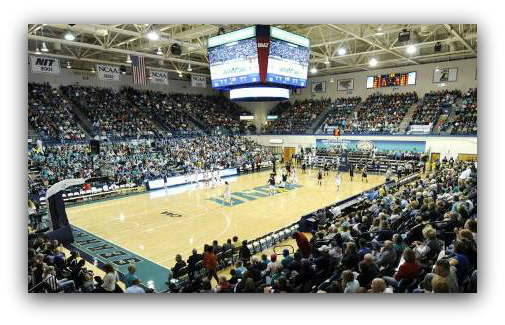 The UNCW women’s basketball program completed its 37th season of competition in 2010-11, including the last 25 as a member of the NCAA Division I ranks. The Seahawks began as a member of the Association for Intercollegiate Athletics for Women (AIAW) in 1973-74 and spent 10 years as a member of the AIAW until the association’s disbandment following the 1982-83 season. UNCW then joined the National Association of Intercollegiate Athletics (NAIA) for one season before joining the NCAA Division I ranks as a member of the ECAC-South Conference in 1984 (the league changed its name to the Colonial Athletic Association in 1985).
The UNCW women’s basketball program completed its 37th season of competition in 2010-11, including the last 25 as a member of the NCAA Division I ranks. The Seahawks began as a member of the Association for Intercollegiate Athletics for Women (AIAW) in 1973-74 and spent 10 years as a member of the AIAW until the association’s disbandment following the 1982-83 season. UNCW then joined the National Association of Intercollegiate Athletics (NAIA) for one season before joining the NCAA Division I ranks as a member of the ECAC-South Conference in 1984 (the league changed its name to the Colonial Athletic Association in 1985).
As a member of the CAA, the Seahawks have made two appearances in the CAA championship game, falling both times to Old Dominion (92-49 in 2000 & 76-48 in 2002). UNCW’s best regular-season finish came in 2010-11, when the Seahawks finished in a tie for second place with ODU, one game behind regular season champion James Madison.
The Seahawks are coached by Cynthia Cooper-Dyke, who was named the ninth coach in program history on May 10, 2010. A member of the Naismith Basketball Hall-of-Fame, Cooper-Dyke enjoyed a landmark playing career both in the WNBA as a member of the Houston Comets and internationally in Italy and Spain. She was a member of back-to-back national champion squads at the University of Southern California (1983, 1984) and represented the United States in international competition on five occasions, including the games of the 1988 and 1992 Olympiads.
In its first season under Cooper-Dyke, UNCW established a program record for victories in a season with 24 wins and made its first post-season appearance, accepting an at-large invitation to the 2011 Postseason Women’s National Invitation Tournament. The Seahawks defeated Richmond, 63-54, in the first round, but fell to Eastern Michigan at home in the second round by an identical 63-54 margin. The loss to EMU on March 21, 2011, was the first post-season game ever to be played in Trask Coliseum. The 2010-2011 Seahawks were led by point guard and team captain Emily Jurenka, whose tremendous work ethic had a major impact on the team. “Her hustle was infectious,” Cooper-Dyke said. “She did everything at 110 percent, and I’ve never seen a player spend so much extra time in the gym.”
Additional Athletic Achievements
The men’s swimming and diving team has won the CAA title for 10 consecutive years, from 2002 through 2011. The men’s track & field team won its 10th team title in 2009. The men’s tennis team has won the CAA title twice in the last three years (2009, 2011) by defeating VCU. The men’s golf and women’s golf teams each won the CAA title in 2011 to give them three conference championships apiece. UNCW also captured the men’s and women’s CAA soccer titles in 2009.


Club Sports
UNCW club sports include teams in baseball, crew, equestrian, gymnastics, women’s lacrosse, men’s lacrosse, women’s soccer, men’s soccer, surf, triathlon, men’s volleyball, women’s volleyball, water-ski, field hockey, ice hockey, rugby, women’s rugby, swimming, men’s ultimate frisbee, women’s ultimate frisbee, water polo, women’s basketball, cycling, golf, sailing, softball, tennis, wakeboard and wrestling.
Both of UNCW’s club ultimate frisbee teams, the Seamen and the Seaweed, are nationally-ranked contenders in USA Ultimate’s college Open and Women’s divisions respectively. In 2010, both teams won their way to the quarterfinals of the USA Ultimate College Championships, each coming away tied for 5th overall.
 The club ice hockey team plays in the Blue Ridge Hockey Conference in the Carolina division. The won their division in the 2007-2008 and 2008-2009 seasons. They were runner ups in the BRHC Championship in the 2007-2008 season. They are currently ranked in the South division of the D3 American Collegiate Hockey Association (ACHA). The team is funded by players and sponsorship donations, for more information, or to donate, visit www.uncwhockey.com.
The club ice hockey team plays in the Blue Ridge Hockey Conference in the Carolina division. The won their division in the 2007-2008 and 2008-2009 seasons. They were runner ups in the BRHC Championship in the 2007-2008 season. They are currently ranked in the South division of the D3 American Collegiate Hockey Association (ACHA). The team is funded by players and sponsorship donations, for more information, or to donate, visit www.uncwhockey.com.
The UNCW Mens Rugby team, the Clamdiggers, was recently admitted back on campus in spring 2010. Since then they have achieved national ranking in the D2 division and was ranked 18th in Fall 2010 and 22nd in spring 2011 with victories over Nationally ranked D1 NC State and Previously #1 ranked Appalachian State”
In addition, numerous other clubs have attained notable accolades. The Surf Club finished 3rd in the 2011 NSSA National Championships, won the NSSA Eastern Championships, placed in the 2010 NSSA National Championship, were NSSA Easterns Champions 2010, were NSSA National Runner-up 2009, and were NSSA Easterns Champions 2009. The Golf Club won the National Championship in 2009 and was a 2011 National Championships Qualifier. The Women’s Club Basketball Team won the East Coast Division II Championship. In 2011, the Men’s Club Lacrosse Team won the War at the Shore Lacrosse Tournament. There are 29 active spots clubs on campus.
Intramural Sports
Intramural sports involve a large percent of the campus body population with dozens of sports from flag football to volleyball to bocce. With warm sunny weather favorable to being outside the majority of the year, the student body is in tuned with participating in IM sports to get involved, meet new people, have fun, and stay active.
Senior Services and Healthcare
Over the past few years, the business of retirement has become a major industry in southern coastal areas. This is due in part to a relative low tax rate, to a decidedly diverse cultural atmosphere, easy access to world class medical facilities, and the maritime location which makes the climate unusually mild for this latitude. Warm spring breezes, hot summers, a mild autumn and few days of freezing winter temperatures create a friendly weather pattern for retirees from the North who yearn for the warm weather of Florida, but still want to experience the seasons. Many services geared to retirees have been established in this area.
On the state level, 12 percent of North Carolina’s population is in the age 65 and older category, and about 14 percent of New Hanover County residents are older than age 65. That number increases to 52% in the city of Wilmington. The percentage of residents over 65 is projected to grow as the number of retirees continues to increase. In response, planned retirement communities, senior services, recreational opportunities aimed at retirees and other enterprises represent a major component of the local economy. As retirees flow into the area, they bring their nest eggs with them, thereby giving them the ability to contribute to the local economy. An added benefit is their contribution of skills and knowledge to area volunteer organizations.
Healthcare is big business in the region. More than 450 physicians and five hospitals employ large numbers of medical personnel. The largest employer is New Hanover Regional Medical Center, with nearly 4,700 employees. Local healthcare services are extensive, and many are comparable with the best state-of-the-art medical facilities and services in the nation. An example is the Zimmer Cancer Center at the New Hanover Regional Medical Center, providing complete cancer care in one facility.
The rapidly expanding seniors’ healthcare market is a national phenomenon, but it is particularly pronounced in coastal/resort communities. In addition to extensive medical services, New Hanover, Brunswick and Pender counties offer a large and constantly growing number of domiciliary care facilities.
TRANSPORTATION
Highway System
An overall network of area highway systems makes Wilmington attractive and easily accessible, both for travelers and industry. U.S. Highway 17, a long major artery from New York to Florida, is currently being four-laned from the South Carolina state line north to the Virginia State line. A bypass around Wilmington is also in the works. Interstate 40 provides a direct connection from Wilmington to Raleigh, Durham, Chapel Hill, Burlington, and Greensboro, as well as other cities across the state. In fact, this east-west highway that begins in Wilmington, stretches all the way across the country to Barstow, California.
Air Transportation
Serving southeastern North Carolina, the Wilmington International Airport (ILM) is located on 1,500 acres, three miles northeast of Wilmington. The airport is operated by the New Hanover County Airport Authority: 1740 Airport Boulevard, Wilmington, N.C. 28405. With flight options through Delta Airlines and US Airways, ILM offers many non-stop flights to popular destinations within the US such as New York City, Atlanta, Philadelphia, and Washington DC. Serving over 3/4 million passengers per year, ILM prides itself on its convenient flight options, ease of use, and extremely friendly staff.
The airport is open 24 hours a day and the control tower is operated 18 hours a day. A Federal Inspection Station at the airport provides entry, clearance and documentation for foreign flights by U.S. Customs, Department of Agriculture and I.N.S. The National Weather Service maintains a facility at the airport which serves aviation needs by disseminating weather information to the entire region.
Three full service Fixed Base Operators provide a complete range of aeronautical services, including hangar storage, tie downs, aircraft sales and service, fuel sales, flight instruction, aircraft charter and rentals, and major and minor airframe and engine repairs. The airport provides a full time, professional Public Safety Office staffed by fully trained and certified law enforcement officers, firefighters and medical technicians to provide efficient security and aircraft rescue/firefighting protection.
Railways
The Wilmington area is served by CSX Transportation, a major freight line that provides freight transportation to twenty states, the District of Columbia and Ontario, Canada. From Wilmington, several spurs serve Wilmington area customer in Castle Hayne, Coastal, Hanover and Malmo. Freight destined to and from these customers is shipped west to yards at Pembroke and Hamlet, N.C., for daily distribution to shippers and receivers all across the United States on CSXT’s fast north-south mainline trains.
Whiteville, Chadbourn and Myrtle Beach are served by Mid-Atlantic and Waccamaw Coastline shortline railroads. Local service to customers in all these areas is performed by local trains and/or switch engine assignments. Major customers include the North Carolina State Ports Authority in Wilmington.
Just west of Wilmington, CSXT operates Davis classification yard, which meets the continuing and increasing needs of Wilmington and this area.
Bus and Taxi
Local bus service is provided by Wave Transit on six fixed routes throughout the City (7 days a week, 5:45 a.m.-8:00 p.m.); three shuttles; a free downtown trolley, and through the Seahawk Shuttle services. Wave Transit also provides paratransit service for disabled individuals and has a taxi voucher program in place for visually impaired citizens.
Greyhound is the one inter-city bus line that operates daily, involving several departures. Arrival schedules are posted daily or call (910) 762-6625. Several taxicab companies provide service to the Greater Wilmington Area.
Wilmington Harbor
Maintained by the U.S. Army Corps of Engineers, Wilmington Harbor is served by 36 miles of navigation channels, two turning basins and one anchorage basin used for turning the largest ship in the harbor. The entrance channel, 44 feet deep and 500 feet wide, crosses the ocean bar and continues to deep water at Southport. From there to the upper end of the anchorage basin at the foot of Castle Street, the navigation channel is 42 feet deep and 400 feet wide. From Castle Street to the Hilton Bridge over the Northeast Cape Fear River, the channel is 38 feet deep and 400 feet wide. From Castle Street to the Hilton Bridge over the Northeast Cape Fear River, the channel is 38 feet deep and 400 feet wide with increased widths at bends. The remainder of the harbor’s channel is 25 feet deep by 200 feet wide and extends 1.7 miles up the Northeast Cape Fear River.
Opposite the State Ports is an anchorage/turning basin 42 feet deep, 1200 feet by 1200 feet. In addition, a 111-mile-long channel links the deep water port of Wilmington with Fayetteville. The depth of that channel which accommodates barges and smaller vessels varies from 25 feet, 12 feet and 8 feet.
Another component of harbor improvements is the construction of a 6.2-mile-long by 600-foot-wide passing lane near the mid-point of the navigation channel between the Atlantic Ocean and the N.C. State Ports Authority terminal. This project would also include widening 5 of the turns along the harbor channel.
Additional features of the plan, as described in the June 1996 Feasibility Report are: no improvements up to 750 feet above the Hilton Railroad Bridge; then deepening the existing channel from 25 to 34 feet to the Arcadian corporation, approximately 2 miles. The plan also includes extending the length of the anchorage basin and widening the turning basin across from the Arcadian Corporation.
ARTS & CULTURE
Wilmington has been ranked as one of the 100 Best Small Art Towns in America. The proof of our vibrant arts community can be viewed virtually everywhere one travels: on the walls of local eateries and coffee houses, in the large selection of commercial art galleries, at arts and crafts fairs, and in the numerous community theatre companies that put on shows year round. Stroll through downtown Wilmington on a week night or weekend and you’ll see and hear theatre coming from traditional venues, such as historic Thalian Hall, and some less likely places: underground bars, the public radio station and outdoor courtyards.
Thalian Hall Center for the Performing Arts
Thalian Hall opened in 1858. It is downtown’s centerpiece for plays, musicals, concerts and dance. Once the stage where locals flocked to see such greats as Lillian Russell and John Philip Sousa, visitors still enjoy touring concerts and productions from around the world, as well as high quality local theatre.
Kenan Auditorium
The Sarah Graham Kenan Memorial Auditorium on the campus of UNCW is home to the Wilmington Symphony Orchestra. Kenan also holds student theatre, hosts touring acts from around the world, and performances by local musicians.
Community Arts Center
The Community Arts Center is one of the last remaining USO buildings from World War II. The Arts Center hosts theatre companies and features hands-on classes in pottery, painting, yoga, and more. The center also presents performance productions, festivals and events.
Visual Arts
In Wilmington alone, there are dozens of art galleries and spaces where visual art is regularly displayed. The entire region is populated by an astonishing numbers of professional painters, illustrators, potters, paper makers, collagists, printmakers, metalsmiths, sculptors, woodcarvers, weavers, basketmakers, and craftspeople.
The pinnacle of visual arts display is the Louise Wells Cameron Art Museum, located at the intersection of Independence Blvd. and 17th Street Extension. The museum houses the largest collection of North Carolina art. This 45,000 square foot state-of-the-art facility–designed by noted Guggenheim-addition architect Charles Gwathmey—features North Carolina and American art from the 18th century to the present, and includes a sculpture garden, café and expansive museum gift shop.
Cape Fear Museum
The overall cultural heritage of the Greater Wilmington area is preserved and displayed in the Cape Fear Museum on Market Street. Established in 1898 as the New Hanover County Museum, it was dramatically renovated in 1992. The museum is laid out to guide the visitor from pre-colonization days to the present, pausing to showcase important historical events along the way, and also features quality, traveling exhibitions.
The museum also displays interesting local artifacts, such as basketball star Michael Jordan’s high school uniform, as well as the Michael Jordan Discovery Gallery, an interactive natural history exhibit for the entire family.
